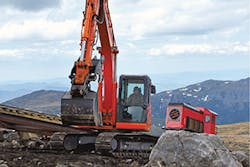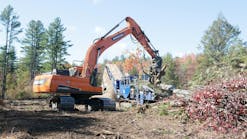What do you do when faced with an insurmountable challenge of completing a construction project on the highest peak in the Northeast? Some would shy away from such an endeavor, but not the team at the Mount Washington Cog Railway, and they are proving their point with some help from a 14-metric-ton crawler excavator and a pair of attachments.
Reaching the highest peak in the Northeast may have seemed unattainable during the mid-1800s, but not to Sylvester Marsh, who produced the world’s first cog-driven mountain-climbing train to climb to the summit of Mount Washington. Since then, the Mount Washington Cog Railway, located in New Hampshire, has become a successful tourist destination—approximately 92,000 visitors during each of the last three years—by operating one steam and five biodiesel cog-driven locomotives.
To help with the influx of visitors, a fourth railway switch, located about 500 feet below the summit, is being installed using a Doosan DX140LCR-3 crawler excavator and attachments. The additional railway switch is a three-phase project and will eventually help guide trains from one track to the other, increasing the frequency of passenger visits to the summit. Once visitors reach the summit, they can enjoy the 45-acre Mount Washington State Park; the Mount Washington observatory; and a building with a gift shop, museum, restaurant, and concessions. One of the original summit buildings, called the Tip Top building, built in 1853, is still there.
Facing Unique, Challenging Conditions
Mount Washington (elevation 6,288 feet) is known for its erratic weather and fluctuating temperatures. According to www.mountwashington.org, temperatures at the summit can vary throughout the year—from -49 to 74°F. Snow is also prevalent on the summit, with an annual snowfall amount of 177 inches (14.75 feet). Average wind speeds are 37 miles per hour, and the highest wind velocity ever observed by man was at the summit of Mount Washington in April 1934, at 231 miles per hour. Because of the Arctic-like conditions at the summit, Gareth Slattery, general manager at the Cog Railway, knew it would be a challenge building a fourth railway switch, even during warm spring months.
“When we get up on the mountain, we can’t just run a mechanic up there to fix any problems we may have,” says Slattery. “I needed a machine that would perform well, especially in this application.”
After consulting with Jim Mullen, his local equipment sales contact, Slattery decided to rent a Doosan DX140LCR-3 reduced-tail-swing excavator because of its reliability and operating weight—approximately 15 metric tons—to fit on the haul cart. He rented the crawler excavator from the local Doosan heavy equipment dealer, Equipment East, located in Dracut, MA, approximately three hours south of Mount Washington. “I can count on Jim [at the dealership] to send me a machine that is functional,” says Slattery.
Overcoming Obstacles
A variety of challenges can arise on even the simplest of job sites. Slattery faced multiple challenges, too, including how to transport the DX140LCR-3 to the project site.
“We had to get the machine delivered to the base station before April 1 because of the road ban,” he says. “The roads become soft in spring because of melting snow, so we can’t haul heavy loads.”
To get the excavator to the job site, Slattery had mechanical engineer, Al LaPrade, design a cart to haul the excavator to the project site. The cart was made to haul approximately 32,000 pounds, so a machine heavier than the Doosan DX140LCR-3 could not have been transported. “We are limited by size because the railway track can’t bear much more load,” says Slattery. According to Slattery, LaPrade designed all of the diesel locomotives for the Cog Railway, as well as the switches, and has been instrumental in the construction of the fourth switch near the summit.
Once at the job site this spring, workers dealt with unrelenting snow and ice, even in May. For instance, before working on the fourth switch installation, workers had to move 2-foot-wide rocks using the DX140LCR-3 with a bucket and a hydraulic clamp. After the rocks were moved, more than 8 feet of snow had to be cleared so work could continue on the fourth switch. If that wasn’t challenging enough, 2 feet of ice had settled underneath the snow. Below the snow and ice is solid ground that never really thaws, known as permafrost.
“When there is permafrost and you have ground that hard, you have to use a hydraulic breaker to loosen the soil,” says Slattery. “You cannot battle permafrost with just a bucket.”
Slattery paired the DX140LCR-3 with a Doosan hydraulic breaker attachment to help break up the frozen ground, allowing for a more malleable surface to lay the support beams. “We flattened out spots for our pedestals for that switch to sit on,” he says. “We created some semi-flat spots for the ‘benches’ to go in. A lot of what the excavator did is act like a crane and lift beams into place.”
The DX140LCR-3 worked on the project until the end of June. The excavator will be brought down from the site and a second Doosan excavator will be used again next spring to continue the project. “We hope to have the project finished and the fourth switch operational by July 2016,” says Slattery.
Adding a fourth switch will improve the Mount Washington Cog Railway’s operating efficiency to better manage passenger traffic up and down the mountain. “When we get the fourth switch installed, we will have an additional siding on the summit that will allow us to run 45-minute schedules,” he says. “The schedule is set up now so when the train arrives at the summit, it unloads passengers and the passengers from the previous hour get on the train and come down the mountain. With the new schedule, the locomotive will be able to get up there and stay with the passengers.
“We will be adding at least one additional trip a day, if not two, and the passengers can go up and come down on the same train.”
Keeping It In-House
Since 1869, locomotives at Mount Washington Cog Railway have been built in-house using materials obtained locally. Each locomotive costs approximately $700,000 to build and are made onsite to fit the intricate cog system. A pair of hydraulically driven cog gears, engaged in a stationary cog rack and installed between the rails provides the tractive force to propel the train up the mountain at an average grade of 25%.
“The steam locomotives were so unique when Sylvester first came up with the idea in 1865, so they had to design everything in-house,” says Slattery. “The steamers, for instance, had tilted boilers to compensate for the grade and were specifically made for our tracks.”
Although the railway moved away from producing steam locomotives, one continues to travels to the summit, the first trip every morning, which takes approximately an hour and 15 minutes. Each steam locomotive requires one ton of coal and 1,000 gallons of water to move the 18-ton engine and coach to the summit. The train stops halfway up the mountain to take on water, and passes a series of complex solar-powered switches that allow the trains to pass one another.
Today, the Mount Washington Cog Railway primarily uses five biodiesel locomotives, which were first introduced in 2008, to help reduce emissions and conserve fossil fuels. It takes approximately 37 minutes and 18 gallons of biodiesel fuel for each of these locomotives to reach the summit.
During winter months when the attraction is closed, railway employees perform various maintenance tasks, including fabrication of cog racks for the cog system. The shop welder, Ryan Mooney, will build 70–120 racks during winter and the track crew will install them in spring.
The uniqueness of the cog design is something employees at the Mount Washington Cog Railway take pride in. With the help of the Doosan DX140LCR-3 excavator, employees will continue to utilize steam and diesel locomotives on the cog railway and be able to accommodate visitors for years to come.



